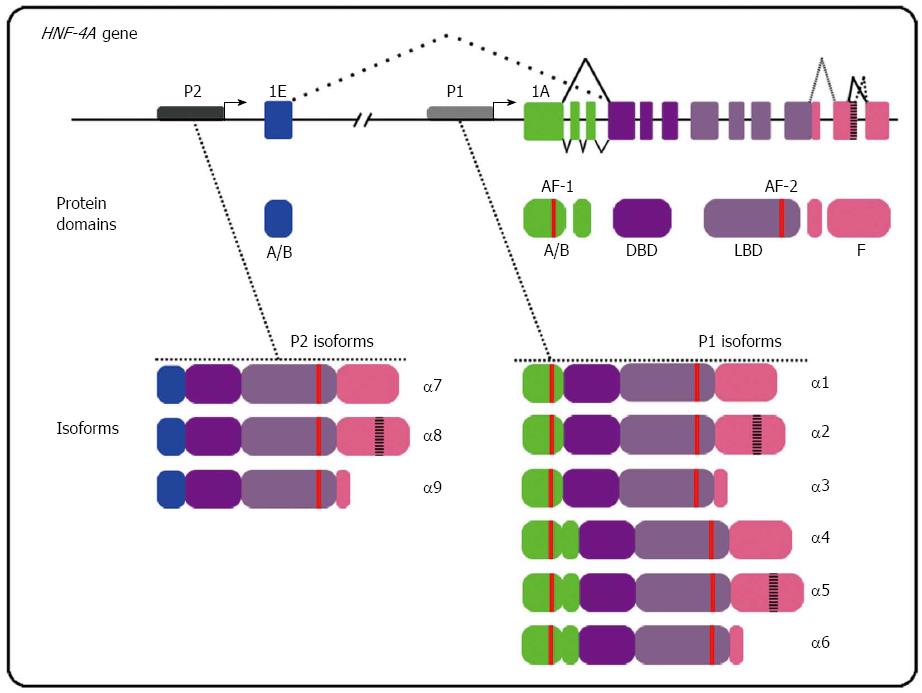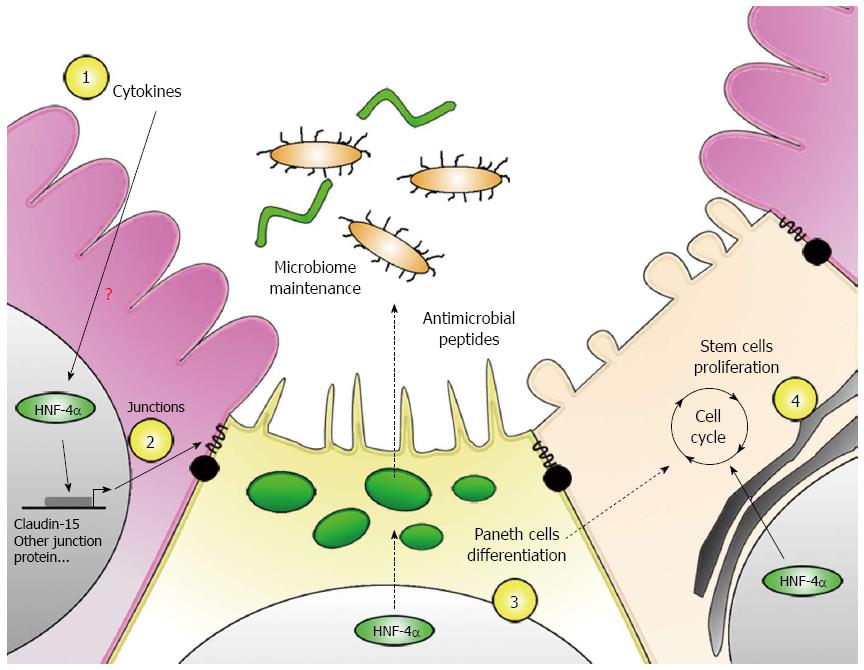Copyright
©2014 Baishideng Publishing Group Co.
World J Gastroenterol. Jan 7, 2014; 20(1): 22-30
Published online Jan 7, 2014. doi: 10.3748/wjg.v20.i1.22
Published online Jan 7, 2014. doi: 10.3748/wjg.v20.i1.22
Figure 1 Hepatocyte nuclear factor 4-alpha P1 and P2 isoforms classes originate from alternative promoters and splicing.
HNF4-α contains two distinct promoters (P1 and P2) that drive expression of nine known isoforms (α1 to α9). Transcription through the P1 promoter allows the inclusion of the exon 1A coding for the N-terminal domain of HNF4-α. P1 isoforms class displays a N-terminal region containing the cofactor interacting domain designed as AF-1. Transcription through the P2 promoter allows the inclusion of the exon 1E but the exclusion of the exon 1A. P2 isoforms class displays a smaller N-terminal domain than P1 isoforms and does not contain the AF-1 region. Alternative splicing of the last exons of HNF4A modifies the regulating F domain of both isoforms classes while alternative splicing of exon 1A modifies only A/B domain of the P1 isoforms. HNF4-α: Hepatocyte nuclear factor 4-alpha; DBD: DNA binding domain; LBD: Ligand binding domain; AF-1: Activating function-1; AF-2: Activating function-2.
Figure 2 Cytokines effect on hepatocyte nuclear factor 4-alpha activity and inflammation associated-cancer in hepatocytes.
Cytokines regulate hepatocyte nuclear factor 4-alpha (HNF4-α) function through its proteosomal degradation, DNA binding affinity, transcriptional activity and cofactor interaction (left panel). HNF4-α participates also to a retro-inhibition feedback loop of the oncogenic interleukin (IL)-6/STAT3 pathway (right panel). In hepatocytes, HNF4-α binds to miR-124 promoter and activates its transcription. MiR-124 targets IL-6 receptor transcript to decrease its expression and then block the activation of IL-6 pathway. On the other hand, stimulation of hepatocytes by IL-6 activates the phosphorylation of STAT3 that binds and transactivates the promoters of miR-24 and miR-629. These two microRNA target HNF4-α transcript and decrease its expression to relieve inhibition of the IL-6 pathway. The perturbation of this molecular circuit ultimately results in the sustained activation of the oncogenic STAT3 pathway and the loss of the tumour suppressor effect of HNF4-α P1 isoforms.
Figure 3 Hepatocyte nuclear factor 4-alpha potential physiological roles in protecting the gut against inflammation.
There are several hypotheses for the functional roles of hepatocyte nuclear factor 4-alpha (HNF4-α) in the context of intestinal inflammation. As observed in hepatocytes, intestinal epithelial HNF4-α could sense and regulate cytokines effect on gene transcription (1). Among others, HNF4-α could influence mucosal barrier properties by regulating the expression of cell junction proteins such as claudin-15 (2). Moreover, HNF4-α could influence microbiota homeostasis through its role on Paneth cells differentiation (3) and goblet cells mucins expression (not shown). Finally, HNF4-α could also be implicated in the maintenance of the regenerative properties of the mucosal barrier. It could participate to stem cells proliferation through maintaining Paneth cells differentiation and through indirect regulation of the β-catenin pathway (4).
- Citation: Babeu JP, Boudreau F. Hepatocyte nuclear factor 4-alpha involvement in liver and intestinal inflammatory networks. World J Gastroenterol 2014; 20(1): 22-30
- URL: https://www.wjgnet.com/1007-9327/full/v20/i1/22.htm
- DOI: https://dx.doi.org/10.3748/wjg.v20.i1.22











